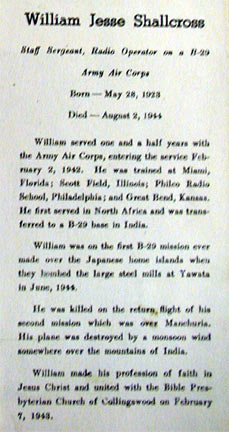|
|
|
|
|
STAFF SERGEANT WILLIAM JESSE SHALLCROSS was born on May 23, 1923 in Cape May NJ to Howard Walter and Mary Mott Shallcross. He was the fourth of five children, coming after sisters Beatrice, Anna, and Mildred, and before younger brother Harry. Howard Shallcross born in Camden NJ, and worked as radio operator in the merchant marine. Sadly, Howard Shallcross passed away in Atlantic City NJ on September 19, 1929. The Shallcross family had moved to 821 Merrick Avenue in Collingswood NJ by the time of the April 1930 census. Known to friends as Billy, William Shallcross attended Collingswood High School, in Collingswood NJ. Having a background in radio from his father, he qualified for flight duty, and was inducted into the Army Air Force on February 2, 1942, and trained as a radio operator at Miami Florida, Scott Field IL, the Philco Radio School in Philadelphia PA and Great Bend KS before shipping out with his crew in the then very new B-29 Superfortress bombers, to India by way of North Africa. Staff Sergeant Shallcross and his crew
participated
in the first B-29 raid against Japan on June 15th, 1944 when 47 B-29s of
the 58th Bombardment Wing attacked the steel works at Yawata. This raid
originated in India, with a refueling stop in China. It involved long
hours in the air and flying over the Himalayan Mountains.
On the return flight from his second mission, the aircraft carrying Sergeant William Jesse Shallcross was caught in a monsoon wind and crashed. His body and those of his comrades were burned beyond recognition, and he and his crew were buried together, first overseas, then on November 17, 1949 at the Jefferson Barracks National Cemetery in St. Louis MO. He was survived by his mother, Mrs. Mary Shallcross of 708 Atlantic Ave., Collingswood NJ, his brother Harry, and two sisters, Mrs. Mildred Smith and Mrs. Anna Fiedler. |
||||||
|
The Gathering Storm The first B-29 bombing raid took place
on June 5, 1944. Led by General Saunders himself, 98 B-29s took off from bases in
eastern India to
attack the Makasan railroad yards at Bangkok, Thailand. This involved a 2,261 mi
(3640km) round trip,
the longest bombing mission yet attempted during the war. The engines of the B-29
were still causing
problems, and fourteen B-29s were forced to abort because of engine failures. The
target was obscured by
bad weather, necessitating bombing by radar. The formations became confused and
dropped their bombs at
altitudes between 17,000-27,000 ft (5200-8200m) rather than the planned
22,000-25,000 ft (6700-7600m.)
Only eighteen bombs landed in the target area. Five B-29s crashed upon landing after
the mission and 42
were forced to divert to other airfields because of a shortage of fuel. The B-29
campaign was off to a
bad start, although none of the bombers were actually lost to enemy action.
|
||||||
|
MACR Report 11299 lists aircraft 42-6228, being lost, with three of the crew killed on August 2, 1944. |
||||||
|
Camden Courier-Post * November 11, 1949 |
||
|
|
|

|
|
CLICK ON THE PICTURES FOR ENLARGED VIEW |
||
RETURN TO CAMDEN COUNTY WAR DEAD INDEX
RETURN TO COLLINGSWOOD NJ WWII NJ WAR MEMORIAL